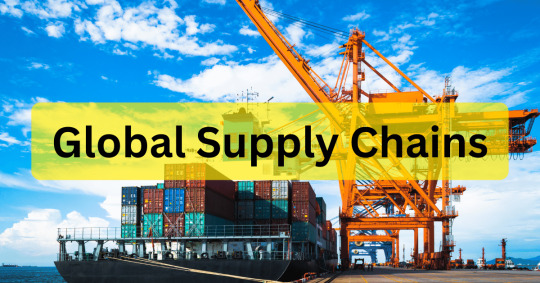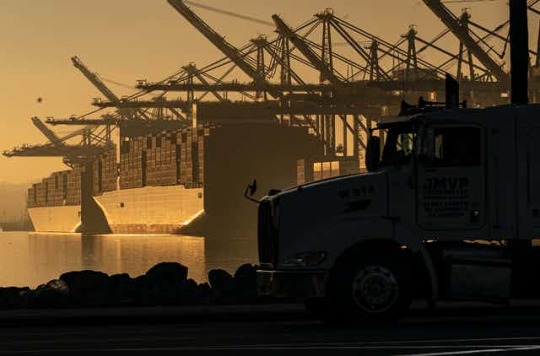#Global Supply Chains
Text
The Radical Democratizing Power of a Better Way to Make Things, With Sarah Hutton
Have the inhumanity and environmental destructiveness of global supply chains got you down? What about the rapaciousness of multinational corporations who have twisted globalization into a nightmare for so many people on Earth? Here’s one thing you can do about it: you can support the growing movement known as distributed production. In Episode 3 of Season 4, researcher Sarah Hutton of the Internet of Production Alliance explains what distributed production is, why it’s all about people power, and exactly why it is a completely radical and powerfully democratizing activity that is also better for local jobs, local communities, and the environment. Listen here!
Join the Internet of Production Alliance’s Community Forum at https://community.internetofproduction.org/
Support Solarpunk Presents on Patreon or make a one-time donation via PayPal.
4 notes
·
View notes
Text
The Changing Nature of Global Supply Chains
The landscape of global trade and supply chains is perpetually evolving, more so under the weight of rising inflation experienced in recent times. In our recent podcast episode, we dissect the intricacies of inflation’s impact on supply chains and the subsequent ripple effects on consumer experiences and economic strategies. We analyze the U.S. inflation rate which reached 2.8% in March and the…

View On WordPress
#Air Quality#Automation#Automotive Industry#Chain Reaction Podcast Tony Hines#Global Supply Chains#Post Brexit Trade Disruptions#Resilience#Supply Chain Strategies#Warehousing
0 notes
Text
Vision Zero Fund forum 2024: Occupational safety and health in supply chains: Challenges and opportunities.
Since the establishment of the Vision Zero Fund (VZF) in 2015, much progress has been made in relation to improving workers' occupational safety and health (OSH). However, despite these successes and achievements, much work still needs to be done.
Vision Zero Fund forum 2024: Occupational safety and health in supply chains: Challenges and opportunities

#occupational health#occupational injury#safety and health at work#Vision Zero Fund (VZF)#supply chains#global supply chains#panel discussion
0 notes
Text
UNCTAD - Press Conference: Rebeca Grynspan on UNCTAD's 60th anniversary.
UNCTAD Secretary-General Rebeca Grynspan briefs the press in Geneva
Watch the UNCTAD's 60th anniversary Press Conference!

#unctad#press conference#60th anniversary#trade#economic growth#development#UN Trade and Development#Global supply chains#Global Leaders Forum#global crisis
0 notes
Text
In today’s interconnected world, global supply chains play a vital role in delivering goods and services seamlessly across borders. Yet, this complex web of interconnected players and processes also exposes businesses to a multitude of risks that can disrupt operations, damage reputations, and erode profitability.
0 notes
Text
Digital Solutions Drive e-Commerce Growth, Revolutionizing Logistics Globally

Shipping and Logistics Companies in Dubai
https://e-ship.sg/assets/img/blog/digital-solutions-drive-e-commerce-growth-revolutionizing-logistics-globally.jpg
The exponential rise of e-commerce has reshaped the retail landscape, propelling traditional shopping paradigms into a digital realm accessible with a simple click. This surge in online retail activity has generated unprecedented demand for logistics services, particularly in key hubs like Dubai. However, logistics companies in Dubai and across the UAE face the challenge of meeting this growing demand while ensuring efficiency and cost-effectiveness.
Fortunately, digital innovations have emerged as a game-changer, offering solutions to streamline logistics operations and capitalize on the e-commerce boom. Let's explore how these digital advancements are transforming
the logistics landscape in Dubai and beyond.
Impact of e-Commerce Growth on Dubai Logistics
Dubai, as a global trade and logistics hub, is at the forefront of e-commerce expansion in the region. The rapid growth of online retail has significantly impacted logistics companies in Dubai, necessitating innovative approaches to handle the influx of shipments efficiently.
Freight Platforms Revolutionizing Logistics
In response to the evolving needs of e-commerce logistics, platforms have emerged as a cornerstone of digital transformation in the industry. These platforms serve as comprehensive ecosystems connecting shippers with carriers, streamlining transactions, and optimizing shipping processes. For logistics companies in Dubai, these platforms provide access to a vast network of shipping options, facilitating seamless and cost-effective deliveries for e-commerce retailers.
Optimizing Ocean Freight Services in Dubai
Given Dubai's strategic location as a maritime gateway, ocean freight plays a crucial role in e-commerce logistics. Digital solutions enable logistics companies to leverage real-time data to optimize ocean freight rates, ensuring competitive pricing and reliable shipping routes. This strategic approach helps Dubai-based businesses remain competitive in the global e-commerce market.
Automation Drives Efficiency
Automation technologies are driving efficiency and productivity in Dubai's logistics operations. Robotics and AI-powered systems streamline warehouse processes, from order processing to packing and sorting. By minimizing human error and accelerating order fulfilment, automation enhances the overall efficiency of e-commerce logistics in Dubai.
Enhanced Visibility and Tracking
In the era of e-commerce, visibility and tracking are paramount for customer satisfaction. Digital solutions offer enhanced tracking capabilities, allowing customers to monitor their shipments in real-time. This transparency not only builds trust but also enhances the overall shopping experience for e-commerce customers in Dubai.
Data-Driven Decision-Making
Data analytics play a crucial role in optimizing logistics operations in Dubai. By leveraging data from various supply chain touchpoints, logistics companies can make informed decisions, identify areas for improvement, and enhance overall performance. This data-driven approach is instrumental in meeting the evolving demands of e-commerce logistics in Dubai's dynamic market.
Conclusion
Digital solutions have revolutionized e-commerce logistics in Dubai, empowering logistics companies to meet the growing demands of online retail effectively. From freight platforms to automation and data analytics, these digital innovations are driving efficiency, competitiveness, and customer satisfaction in Dubai's logistics sector. As e-commerce continues to thrive, the collaboration between technology and logistics will shape the future of retail and shipping and logistics companies in Dubai and beyond.
#Dubai logistics#Logistics Companies in UAE#Ocean freight Shipping in Dubai#shipping companies in UAE#supply chain optimization in UAE#Global Supply Chains#Digital Freight Forwarding Companies UAE#Digital Freight Forwarders UAE#LCL Shipments UAE#LCL Services UAE#Less than Container Load
0 notes
Text
Strategies for Enhancing Collaboration in Global Supply Chains

In today’s interconnected world, the efficiency and resilience of global supply chains are not just about moving goods from point A to point B. They hinge on the power of collaboration - a vital element that harmonizes the complex network of relationships and processes spanning continents. Collaboration in global supply chains is the linchpin for success, driving efficiency, innovation, and resilience against disruptions. This article aims to shed light on the intricacies of global supply chains and the pivotal role collaboration plays within them. We delve into the complex tapestry of international logistics, highlighting the importance of seamless cooperation among diverse entities and exploring the multifaceted strategies to enhance collaboration across these vast networks.
The Foundation of Collaborative Supply Chains
Understanding the Dynamics of Global Supply Chains
Global supply chains represent a vast ecosystem of suppliers, manufacturers, distributors, and retailers, all intricately linked and interdependent. These supply chains traverse multiple countries, each with its regulatory environment, cultural norms, and logistical challenges. At the heart of these operations are the critical components – from raw material sourcing to manufacturing processes, and from logistics management to final product delivery. The dynamic nature of these global networks demands agility and flexibility, making collaboration not just beneficial but essential for operational success.
Barriers to Collaboration
Despite the apparent benefits, collaboration in global supply chains faces several barriers. Cultural differences can lead to misunderstandings and misaligned objectives, while communication barriers can hinder effective information sharing and joint decision-making. Additionally, conflicting interests among various stakeholders, such as differing priorities or competition for resources, can impede collaborative efforts. Identifying and addressing these challenges is crucial for building a cohesive and cooperative global supply chain network.
The Role of Technology in Collaboration
Technology acts as a great enabler in overcoming these barriers and fostering collaboration. Advanced information systems like Enterprise Resource Planning (ERP) and Supply Chain Management (SCM) software provide platforms for real-time data sharing and analysis, ensuring all parties have access to consistent and accurate information. Cloud computing and IoT (Internet of Things) technologies offer further advancements, enabling more efficient tracking, monitoring, and management of supply chain activities. The integration of AI and machine learning algorithms can predict supply chain disruptions and optimize operations, making the collaborative process more proactive and intelligent.
Building Collaborative Global Supply Chains
Establishing Clear Communication Channels
Effective communication is the cornerstone of successful collaboration in global supply chains. To create effective communication strategies, start by identifying the key stakeholders in your supply chain and understanding their communication preferences and requirements. Utilize a variety of communication tools that cater to different needs, such as video conferencing for face-to-face interactions, and project management software for ongoing task coordination. Establish regular check-ins and updates, ensuring that all parties are aligned and informed. It's also crucial to develop a common language or terminology to avoid misunderstandings, especially when dealing with partners from different cultural backgrounds. Clear, consistent, and transparent communication fosters a collaborative environment where information flows smoothly.
Fostering Trust and Transparency
Building trust and maintaining transparency with global supply chain partners is essential. Trust is cultivated over time by consistently meeting commitments, being honest in communications, and showing respect and understanding for different cultural practices. Transparency can be achieved by openly sharing information such as inventory levels, demand forecasts, and production schedules. Implementing joint policies and agreements on how information is shared and used can also enhance trust. Regular meetings and workshops can help in understanding each partner’s challenges and strengths, further solidifying the trust.
Leveraging Technology for Collaboration
Technology plays a critical role in enhancing collaboration in global supply chains. Implementing integrated supply chain management systems allows for real-time data sharing and visibility across the entire chain. Cloud-based platforms enable partners to access information anytime, anywhere, ensuring that everyone is on the same page. Technologies like IoT can provide real-time tracking of goods, while AI and analytics can offer insights for better decision-making. Collaborative platforms can also facilitate joint planning and forecasting, making the supply chain more responsive and agile.
Trends Shaping the Future of Supply Chain Collaboration

The radar chart above offers a unique perspective on the multifaceted trends that are shaping global supply chain collaboration. As we navigate through 2023 and 2024, these trends are playing a pivotal role in defining the strategies and operational models for supply chains worldwide.
Redesigning Supply Chain Flows: Businesses are actively redesigning their supply chains, focusing on creating more resilient and adaptive flows that can respond quickly to changing market conditions and disruptions.
Addressing Production Delays: The pandemic-induced production delays have prompted companies to re-evaluate and innovate their supply chain strategies to ensure more robust and efficient operations.
Diversifying Third-Party Relationships: There's a marked shift towards diversifying supplier networks to mitigate risks and enhance supply chain resilience against external shocks.
Technology Investment: Embracing advanced technologies like AI, blockchain, and IoT is becoming a cornerstone strategy for businesses to gain a competitive edge in supply chain management.
Commodity Pricing Management: With fluctuating global markets, effective management of commodity pricing is emerging as a key focus area for maintaining cost efficiency and operational stability.
Workforce and Labor Challenges: The changing dynamics of the labor market, coupled with technological advancements, are reshaping workforce strategies within the supply chain sector.
Together, these trends underscore a period of transformation and adaptation in global supply chains. By understanding and strategically responding to these trends, businesses can ensure their supply chains are not just efficient and resilient, but also primed for innovation and growth in the years to come. This comprehensive approach is essential for thriving in the fast-paced and interconnected global economy.
Top Strategies for Enhancing Collaboration in Global Supply Chains
Cultivating Strong Partnerships: Building strong relationships with supply chain partners is fundamental. This involves understanding each other's capabilities and constraints, and working together to find mutually beneficial solutions.
Implementing Collaborative Planning and Forecasting: Collaborative planning and forecasting involve sharing information about demand and supply conditions to optimize inventory levels and production plans. This joint effort ensures a more synchronized and efficient supply chain.
Cross-Cultural Training: Given the global nature of the supply chain, providing cross-cultural training to your team can enhance understanding and cooperation among diverse partners.
Shared Performance Metrics: Develop and agree on common performance metrics to ensure that all partners are aligned with the overall goals and objectives of the supply chain.
Joint Problem-Solving Initiatives: Encourage a culture where partners can collaboratively address challenges and find innovative solutions, strengthening the supply chain’s ability to adapt and evolve.
Leveraging Cloud-Based Platforms: Cloud-based platforms can greatly enhance collaboration by providing a centralized, accessible space for data sharing and communication.
Implementing Blockchain for Transparency: Blockchain technology can be used to create a transparent and immutable ledger of transactions, enhancing trust and traceability in the supply chain.
Fostering Innovation: Encourage an environment where partners can share ideas and innovations. This can lead to improved processes, products, and technologies across the supply chain.
Adaptive Supply Chain Strategies: Develop flexible and adaptive strategies that can quickly respond to changes in the market or disruptions, ensuring the resilience of the supply chain.
By implementing these strategies, businesses can create more collaborative, efficient, and resilient global supply chains. These approaches not only enhance the operational aspects of the supply chain but also contribute to building long-term, sustainable relationships with partners, which are crucial in today's interconnected global economy.
The Future of Collaboration in Global Supply Chains
Emerging Trends in Supply Chain Collaboration
The landscape of global supply chain management is rapidly evolving, with several emerging trends shaping the future of collaboration. Digital transformation is at the forefront, with technologies like AI, IoT, and blockchain revolutionizing how supply chain partners interact and share information. Another trend is the growing emphasis on transparency and real-time data sharing, allowing for more synchronized and efficient operations. Additionally, there’s a shift towards more agile and flexible supply chains, capable of quickly adapting to market changes and disruptions, which necessitates deeper and more dynamic collaboration among all stakeholders.
Overcoming Future Challenges
Looking ahead, global supply chains will face a range of challenges that could impede collaboration. Geopolitical tensions, trade uncertainties, and fluctuating market conditions pose significant risks. Overcoming these challenges requires a proactive approach, focusing on building resilient and adaptable supply chains, fostering strong relationships with partners, and investing in technology that enhances connectivity and information flow. Embracing collaborative innovation, where supply chain partners co-develop solutions, can also be a key strategy in navigating future challenges.
Sustainability and Collaboration
Sustainability is becoming increasingly central to global supply chain operations. Collaborative efforts are crucial in driving sustainable practices, from reducing carbon footprints to ensuring ethical sourcing and production. Collaboration enables sharing of best practices, joint investment in sustainable technologies, and collective efforts in meeting regulatory requirements and sustainability goals. This collaborative approach not only enhances environmental sustainability but also ensures the social and economic sustainability of supply chains.
FAQs on Collaborative Global Supply Chains
What are the key benefits of enhancing collaboration in global supply chains?
Improved efficiency, reduced costs, increased flexibility and resilience, and enhanced innovation are some of the key benefits. Collaboration also leads to better risk management and improved customer satisfaction.
How can technology facilitate collaboration in supply chains?
Technology, such as cloud-based platforms and blockchain, facilitates real-time data sharing, improves visibility across the supply chain, and enables more effective coordination and decision-making.
What are the challenges in achieving collaboration in global supply chains?
Challenges include managing cultural and operational differences, overcoming communication barriers, aligning different objectives and priorities, and ensuring data security and privacy.
Expert Insights and Practical Tips
Expert Insight: To foster collaboration, focus on building long-term relationships based on trust, shared goals, and mutual benefits. Invest in technologies that enhance connectivity and transparency across the supply chain.
Practical Tip: Regularly conduct joint planning sessions with key supply chain partners. These sessions can help align strategies, anticipate market changes, and collaboratively develop contingency plans.In conclusion, the path to a collaborative future in global supply chains is paved with challenges, but it also offers immense opportunities for innovation, efficiency, and sustainability. The key lies in embracing emerging trends, overcoming potential obstacles, and recognizing the critical role of sustainability in collaboration. By harnessing the power of technology, fostering strong partnerships, and prioritizing shared goals, businesses can not only enhance their supply chain collaboration but also ensure their long-term success and resilience in an increasingly interconnected world. This collaborative approach is not just a strategic advantage; it's a necessity in the modern business landscape, where success is increasingly defined by the strength and synergy of global partnerships.
0 notes
Text
Resilient and Responsible Global Supply Chains - Day 1 (Room XXVI) Forum on Business and Human Rights 2023.
12th UN Forum on Business and Human Rights Brief description of the session: It is common for global retailers to engage in transactional or indirect relationships with their suppliers in the global South. These are characterized by short-term interactions with several suppliers based on maximizing cost and order volumes with little commitment to future business and longer-term relationships. Research has shown, however, that a partnership or direct relationship model can create better business opportunities for both sides, as well as contribute to better labor rights. This panel presents research that examines the steps needed to enter into a partnership model and what the advantages might be for every layer of the supply chain. The panel will discuss whether COVID-19 was the tipping point for global brands that may have already been thinking about switching to a direct sourcing model by consolidating their supply chain and committing to longer-term sourcing relationship. This session will cover recent trends, such as the fact that global retailers are currently making changes to their business model due to the realization that the "just in time" manufacturing is not sustainable in the long term. Panelists will present a roadmap to understand the advantages of the partnership model for all stakeholders involved, how to establish a true partnership, the potential risks involved, and how to mitigate these risks. The panel will touch on the challenges and benefits of moving towards this model for global retailers, suppliers, and ultimately workers who are the most vulnerable at the bottom of these supply chains. Key objectives of the session:
Present research on partnership models
Examine global trends and factors that affect value chains
Discuss challenges and benefits of partnership and direct relationship models
Present a roadmap or key steps to create a sustainable and meaningful partnership
Moderators: Auret van Heerden
Speakers: Fernanda Carvalho, Sanchita Banerjee Saxena, Dijana Mozina Zupanc, Abrar Sayem, Payal Jain, Dan Rees
Learn More
#human rights#business and human rights#business enterprises#united nations human rights council#ohchr#civil society#individuals#Meeting#Global Supply Chains#forum#manufacturing#global South#labor rights
0 notes
Link
Supply chain management has become more difficult as supply chains have grown increasingly interconnected. Furthermore, regionalization and the need for optimization have been sparked by external variables such as market instability, pandemic-induced changes, and heightened awareness of the environmental impact of supply chains. To make International Trade finance more effective, inclusive, and equitable, this has interestingly prompted the development of Trade Finance Service to aid small and medium-sized enterprises and other stakeholders in concentrating on supply chain resilience.
These cutting-edge innovations facilitate buy-and-sell discovery platforms and the internal communication and interoperability of service providers such as trade financiers, insurance providers, and logistics firms. For small and medium-sized businesses (SMBs), technology can simplify, broaden, and make fairer international trade.
Funding for Global Commerce
When financial institutions like banks issue financial instruments like Bank Guarantee and letters of credit to importers and exporters, this is known as International Trade finance. International trade finance includes importers, exporters, banks, and specialized finance companies.
Intelligent Supply Networks
Many small businesses are adopting artificial intelligence (AI) based solutions, allowing for the more advanced supply chain management. Models for predicting future demand, end-to-end transparency, dynamic planning optimization for inventory control, and automated process optimization for waste reduction are all part of the picture. To construct prediction models and conduct correlation analysis, each of these factors is essential for identifying the drivers and moderators of supply chain performance.
Following the supply chain crisis, more small and medium-sized businesses have committed to utilizing cutting-edge technologies to provide scalable, user-friendly digital experiences for their staff and customers. From providing staff with cloud-based tools to complete mundane chores to establishing information systems that provide real-time insights on port call estimations, businesses are coming up with novel ways to manage their supply chains.
Blockchain
Shipment and transaction records pertaining to items’ cost, date, location, quality, and certification can be more easily recorded with the help of a blockchain-powered supply chain. Reputation is bolstered as a result of increased supply chain transparency, better traceability and compliance, and lower administrative expenses. This assures the safety of all digital data transfers along the supply chain and ensures that all parties involved have access to the same data.
Small and medium-sized enterprises ( SMEs) can connect with external players in the ecosystem for smooth communication thanks to blockchain and AI technologies that reduce the need for paper documents such as receipts, invoices, tax forms, contracts, financial reports, etc.
An IoT inventory system keeps constant tabs on stock levels for several crucial components to facilitate business choices and forestall shortages. The efficiency of today’s supply chains depends on a wide range of machines, and IoT sensors can be used to evaluate various operational indicators. In the supply chain, for instance, predictive maintenance helps firms take action before potential breakdowns, thereby increasing the lifespan of the equipment in question.
Digital Payments
Due to the large number of interdependent parties involved in conventional Trade Finance Service and supply chain activities, confirming and reconciling data can be a time-consuming process. Although the frequency of such payments varies, the timeliness of payment is sometimes impacted by the need for human verification of information. Distributed ledgers are helpful because they function as trustworthy shared databases where all users can access identical data copies. When a payment is received, or a shipment is registered, the information is promptly authenticated, made visible to all parties involved in the supply chain, and updated.
Cloud Computing
With the help of optimized supply chain cloud platforms, stakeholders such as importers, exporters, insurance providers, transport carriers, etc., may better communicate and adhere to globally standardized procedures.
Tech-Based Logistics
For instance, smart packaging solutions meet the need for secure shipping by allowing for product tracking and providing information on delivery partners’ and shippers’ warehouses. Furthermore, such initiatives typically aid businesses in increasing sales and decreasing costs by enhancing vital logistics processes, decreasing theft, and minimizing trash.
What Role Does Trade Financing Play in Mitigating Risk?
Trade financing can assist in reducing uncertainty when the financial requirements of an exporter and an importer are at odds. An exporter would prefer an up-front payment from the importer to avoid dealing with an unpaid export shipment. However, the exporter will only release the goods if the importer has already paid for them.
The issuing Bank Guarantee payment to the exporter upon satisfactory evidence of shipment and fulfilment of other terms of the Letter of Credit arrangement.
Bank Guarantee serve a significant role in promoting international trade by reducing the risks involved with the failure of a contract, a supplier’s inability to perform as agreed, or a buyer’s failure to pay for products.
The importance of global supply chains needs to be stressed, especially considering how interconnected the globe is. Applying trade-tech solutions like those discussed above will continue to find a position in international trade. They are a digital part of the future of the trading ecosystem, which is moving toward efficiency, inclusivity, and equity.
Originally published at https://www.axioscreditbank.com.
#supply chain#International Trade finance#Bank Guarantee#letters of credit#Trade Finance Service#global supply chains
0 notes
Link
As per the latest news, the fifth UN Global Survey on Digital and Sustainable Trade Facilitation 2023 has been introduced by the five United Nations Regional Commissions and the United Nations Conference on Trade and Development (UNCTAD).
This 2023 edition comprises 60 measures, including two new sets of measures on “Trade Facilitation for e-commerce” and “Wildlife Trade Facilitation”, on international e-commerce and the use of electronic CITES grants and certificates.
It keeps on including measures associated with the arrangements of the World Trade Organization’s Trade Facilitation Agreement covering the agricultural area, small and medium enterprises (SMEs), women traders, and trade finance, as well as crisis measures during times of emergencies.
The preliminary consequences of the 2023 Survey will be released in July, followed by the final consequences as a Global Report and five Local reports.
The above-mentioned survey aims to deliver an overview of the development of the execution of measures on digital and sustainable trade facilitation and intuitive data to help nations in growing their national trade facilitation strategies, such as the National Trade Facilitation Roadmap of the Kyrgyz Republic 2021–2025.
Read more: https://www.emeriobanque.com/news/global-survey-on-digital-and-sustainable-trade-2023-by-un
0 notes
Text
Ukraine war and anti-Russia sanctions on top of COVID-19 mean even worse trouble lies ahead for global supply chains
Supply chains were already in disarray thanks to overcongested ports, as in Los Angeles.
AP Photo/Damian Dovarganes
Tinglong Dai, Johns Hopkins University
Francis Fukuyama, the American political scientist who once described the collapse of the Soviet Union as the “end of history,” suggested that Russia’s invasion of Ukraine might be called “the end of the end of history.” He meant that Vladimir…

View On WordPress
#Belt and Road Initiative#China#Corepaedia#corepaedianews#Food supply chain#Global supply chains#global trade#Grains#Neon#Russia#Semiconductors#Supply chain crisis#Supply chain management#Supply chains#trade#Ukraine#Ukraine invasion 2022#Wheat#كوربيديا#كوربيديا للاخبار
0 notes
Text

#free congo#don't forget about the congo#tesla#glencore#cobalt#nickel#human rights abuses#allegations#mining industry#renewable energy#clean energy#environmental impact#worker mistreatment#corruption#ethical sourcing#global supply chain#corporate responsibility#renewable energy transition#accountability
315 notes
·
View notes
Text
World Economic Forum 2023
The gathering of 2700 influential leaders from 133 countries took place at Davos last week. Cooperation in a Fragmented World was the title of this year’s Annual Meeting. It is the 53rd meeting with 600 of the world’s leading company CEO’s attending. It is a place where many of the world’s pressing problems are discussed and policy prescriptions proposed.
Sustainability is a key focus for all.…

View On WordPress
#Automobiles#China#Disposal#Energy#EV&039;s#EWaste#Food#Global Supply Chains#Jobs for the Future#Rear Metals#Recycle#Reuse#WEF Industrial Startegy Report#World Economic Forum
0 notes
Text
look at what I finally received today

My diploma :)
#Business school ramblings#Im officially a college graduate with a degree in Global Supply Chain Management#I know i deleted tumblr but I feel like a lot of you older mutuals would like to know that I’m finally done with school#Since some of yall have seen me get through the worst of it haha#Dont mind the ‘COLLEGE NAME’ im not about to doxx myself
108 notes
·
View notes
Text
Did you know that 20% of American households are behind on their utility bills, a record high? Coincidentally, did you know that 3 out of the top 5 profiteers of the recent energy and cost of living crisis in the U.S. in 2022 were energy companies--and natural gas company EQT saw their operating profit margin increase to over 60%, also a record high? Come to think of it, did you also know that lower natural gas costs are statistically shown to save lives and prevent up to 11,000 deaths per year? did you know?
#i just wrote a midterm about the human rights violations of u.s. energy and food companies capitalizing on inflation by excessively#raising costs even higher than shifting the supply chain cost increases to consumers#and how that's contributing to poverty in the united states and also violating human rights to food/heat/etc globally#and now im mad. i knew it was bad but seeing the numbers makes it worse#us politics#not spn
35 notes
·
View notes
Text
7 Reasons Behind the Shifts in Global Supply Chains

Global Supply Chains and Logistics Companies in Dubai
The landscape of global supply chains is undergoing significant transformations, driven by various factors ranging from economic shifts to technological advancements. Among the multitude of changes, sea freight remains a cornerstone of global trade, facilitating the movement of goods across continents. However, recent times have witnessed a discernible alteration in how businesses approach maritime freight, with several key reasons fuelling these shifts.
Economic Evolution:
The ever-changing economic environment stands as the primary catalyst behind
the evolving dynamics of global supply chains. Traditional routes and hubs for maritime freight services are being redefined in response to emerging markets and evolving financial circumstances. Businesses strategically realign their supply chain networks to capitalize on new opportunities and optimize sea freight solutions economically.
Technological Innovations Reshaping Operations:
Technological advancements have revolutionized the sea freight industry, fundamentally altering how businesses operate. Automation, data analytics, and the Internet of Things (IoT) have transformed sea freight operations, enhancing efficiency through improved communication, predictive analytics for route optimization, and real-time cargo tracking. The adoption of these technologies provides companies with a competitive edge, catalysing an industry-wide shift.
Emphasis on Environmental Sustainability:
The global movement towards sustainability has compelled shipping companies to adopt eco-friendly measures. As concerns about carbon footprints and environmental impacts escalate, sea freight companies are embracing sustainable shipping practices. By reducing environmental footprints, these companies not only comply with regulations but also appeal to environmentally conscious consumers, driving the shift towards greener alternatives.
Diversification of Risk Management:
The COVID-19 pandemic exposed vulnerabilities in international supply chains, prompting businesses to diversify their risk management strategies. To enhance resilience against disruptions, sea freight companies are exploring alternate routes, suppliers, and sea transportation modes. This diversification encompasses various risk factors, including pandemics, natural disasters, and geopolitical tensions, ensuring the stability of supply chains in turbulent times.
Impact of E-Commerce and Changing Consumer Behaviour:
The surge in e-commerce and evolving consumer expectations have reshaped the demand for sea freight services. With consumers demanding faster and more flexible shipping options, businesses are reevaluating their supply chain models. Sea freight companies that can provide reliable and efficient services are increasingly valued partners in meeting the demands of the modern consumer market.
Strategic Alliances for Cost Efficiency:
To maximize cost efficiency and improve operations, sea freight companies are forging strategic alliances and collaborations. These partnerships enable companies to leverage shared resources, infrastructure, and expertise, enhancing the competitiveness of sea freight services. By creating synergies through collaboration, companies can optimize their bottom line while enhancing the overall effectiveness of global supply chains.
Regulatory Compliance and Adaptation:
Operating in a dynamic regulatory environment, sea freight companies must stay abreast of regulatory changes to ensure compliance. Adhering to international standards and regulations is crucial for maintaining the integrity of global supply chains. Companies that can adapt and comply with evolving regulations are better positioned to offer reliable and compliant sea freight services.
In conclusion, the shifting landscape of global supply chains in sea freight operations is driven by a myriad of interconnected factors, including economic, technological, environmental, and regulatory influences. Embracing these changes and adopting innovative solutions is essential for sea freight forwarder companies to thrive in the evolving landscape. By leveraging these shifts to innovate, collaborate, and prioritize sustainability, companies can navigate the challenges and seize the opportunities presented by this transformative phase, charting a course towards a more efficient, resilient, and sustainable future for global supply chains.
#less than container load#freight forwarders in uae#Global supply chains#logistics companies in Dubai#sea freight operations#global shipping logistics#cargo shipping dubai#shipping companies in dubai#Less than container load#cargo companies in dubai#logistics company near me#logistics and services
0 notes